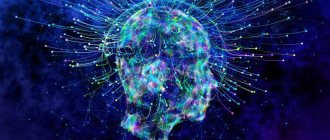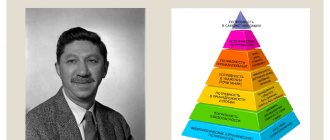Modern psychological science is based on such basic concepts as “personality”, “consciousness”, “activity”, “communication”. Often the concept of activity in psychology is interpreted as a unique form of the subject’s relationship to the world around him. Moreover, this attitude is conscious, aimed at its development and transformation to the extent that it seems appropriate to the individual. The role of consciousness depends on the type of activity - in scientific, work or play, its psychological component is different.
Activity is recognized as the basis for personality formation.
Articles on the topic
- What is professional stress, its main signs and types 08/29/2021
- Self-analysis and self-assessment of a teacher’s professional activity as the main criteria for his work 08/13/2021
- What is the role of self-esteem in choosing a profession 08/13/2021
- What does success in business depend on and how not to lose it 07/12/2021
A purposeful attitude towards the world is realized in the following types: cognitive, evaluative, spiritual or material, reproductive, creative and many others.
What is it in psychology
The first concept was developed by N.A. Leontiev in Soviet times. He first presented his theory in the 1940s, after which he repeatedly refined and changed it.
In the understanding of N.A. Leontief activity is defined in psychology as follows: the term refers to a system of active actions that is aimed at satisfying a need. It obeys the motive and is realized by man.
Important! The concept of “activity” should not be confused with “activity” - these are two different phenomena.
Other psychologists developed N.A.’s idea. Leontyev. Domestic specialists, S. L. Rubinstein and L. S. Vygotsky, also complemented the theory.
Classification
For normal existence, both types of activity are equally important: physical and intellectual. They are interconnected, subordinate to one mechanism aimed at harmonious development.
Physical form
Physical activity refers to movement performed to achieve a goal. The action occurs under the influence of motive and is associated with the work of physical functions. Physical activity is preceded by mental activity - first a person forms an image, then makes an attempt to embody it. Physical activity is necessary to meet the needs of life.
Intelligent Form
Intellectual activity can be realized without the participation of physical activity (thinking does not require physical movements). She participates in satisfying the lower and higher needs of life.
Subject and principles
Behaviorism is in psychology, briefly and clearly
Activity is always aimed at something or someone, i.e. it cannot be pointless. Scientists identify two main principles:
- Functionality - a person relies on already developed mental elements and mobilizes forces to achieve a goal.
- Systematicity - activity always has a certain structure, it is influenced by the individual qualities of the individual.
Psychological activity is of great importance, as it makes it possible to understand the peculiarities of the functioning of the human personality.
Psychological characteristics of activity
The activity has the following features unique to it:
- Subject : each activity has its own subject. The object of activity appears in two ways: primarily - in its independent existence, as subordinating and transforming the activity of the subject, secondly - as an image of the object, a product of the mental reflection of its properties, which is carried out as a result of the activity of the subject and cannot be realized otherwise.
- Awareness and purposefulness . Activity is regulated not by human needs, but by a perceived goal as an ideal image of a future result. The goal is a system-forming factor of activity, i.e., the main criterion for determining its content, structure and dynamics. This is the most important difference between activity and other forms of human activity.
- Social conditioning . For all its originality, human activity is a system included in the system of social relations. Outside of these relationships, human activity does not exist. A person finds in society not just external conditions to which he must adapt his activities - social conditions themselves carry within themselves the motives and goals of his activities, its means and methods. In essence, society produces the activities of the individuals who form it.
- Systematicity . Activity appears not as a simple sum of its components, but as their organized integrity. It is important to note that activity as an integrity has properties that neither its individual components nor their simple sum have.
Differences from activity
Gestalt psychology - what is it in psychology briefly
Not every interaction with the environment is called an activity. Activity is a broader concept; it can describe physical, intellectual and other types of work of the body.
Activity in animals is subordinated to the satisfaction of instincts
Activity is always conscious and has a specific goal. It is believed that it is inherent only to people; animals are not capable of such organization of behavior.
Structure components
The content of the activity consists of cognitive, emotional and volitional components. The first category is also divided into perceptual, mnemonic and mental.
Psychoanalysis by S. Freud - brief and clear
ON THE. Leontiev presents activity in the form of a strict structure that can be divided into several stages. At the first stage, goal setting, task formulation and plan implementation take place. On the second, the result is checked and errors are corrected. At the third stage, the results are summed up and an analysis of the work is done.
Later, other psychologists expanded N.A.’s ideas. Leontyev. Experts put the motive in first place, i.e. defined need. Next, a goal was added to the structure, which can be presented as either the final result or the desired one.
After setting a goal, the individual develops an individual plan for achieving it. Whether a person gets the desired result depends on the adequacy of the means used. Afterwards the results are summed up and evaluated.
Activity in psychology is presented as a complex process that requires a high organization of the psyche. It comes in several types, each of which has its own characteristics.
Knowledge, abilities, skills, habits
Different components are responsible for implementing the program. The success of their implementation depends on the level of their development. Purposeful activity is possible only if there is knowledge - images, sensations and perceptions. They are processed by the brain into concepts and ideas.
Core skills are what enable a person to master certain activities. The method of implementation depends on the thinking and individual characteristics of the individual. In essence, skills allow you to find non-standard solutions to situations and respond to changing conditions. Skills are automated actions. They appear after repeated exercises.
A simple example. In order for a child to learn to read, he needs not only to remember the letters, but also to practice every day, after which he will not think about how to connect syllables into words.
Skills can be motor, behavioral, mental
The development of automated action follows one pattern. First, there is a general familiarization with the techniques of execution, then attempts to perform the action, then practice until it becomes automatic.
Important! Learning new skills is always influenced by old ones.
Habits can be understood as actions that have become a need. They appear through the process of repeated repetition, imitation or learning.
Types and types
There are several main activity options. In psychology, it is customary to distinguish 4 types. From birth, a person receives the opportunity to communicate. To do this, he uses babbling, onomatopoeia and other methods of interaction. After the child begins to include words in speech activity, he gets the opportunity to contact not only his mother.
Gaming activities are aimed at mastering social experience. For example, when playing with dolls, kids practice family roles, then they try on professions, etc. This stage is preparation for work and training.
Educational activities allow you to assimilate information about the world around you. With its help, a person gets the opportunity to choose techniques and operations to achieve goals.
Labor activity is aimed at creating a socially significant product. To do this, a person can work on a joint project or involve other people to carry out his plans.
Types of activities are more widely represented. Cognitive - aimed at obtaining knowledge, artistic - at satisfying aesthetic needs, religious - helps solve issues in the spiritual sphere.
Psychological activity is a multicomponent structure, which is presented in different types and types. It directly affects a person’s development and level of achievement.
The main activities are play, learning, and work.
In the process of transition from type to type, the following occurs:
1. internal changes (related to the structure of motives and needs)
2. external transformations - new objects are involved in the sphere of activity, etc. the scope of activity expands from type to type.
The performance of an activity is influenced by personal states (for example, fatigue), elements of creativity, established stereotypes, and success in its implementation.
Action begins with setting a goal (and proceeds both externally and internally).
Since there are patterns in the world around us, this allows us to anticipate the behavior of objects in changing conditions. And internal activity is based on this. Here, objective actions on objects are replaced by ideal psychologists. operations, either with ideal images of objects, or with their meanings. As a result, internalization occurs (transforming the external into the internal).
Interiorization is the transition from the sensorimotor plane to thought. Exteriorization involves the embodiment of a mental action or image into a reality practically accessible to other people.
An action is a unit of activity. It is expressed in deliberate activity and aimed at achieving a perceived goal. Various signs, roles, values, norms can act as means of action, using which the subject masters actions.
The motives for activity are based on needs.
Individual style
Many psychologists emphasize that any personality theory has fairly general characteristics. Therefore, you always need to take into account the characteristics of a particular person.
Individual style includes temperament, experience, skills, knowledge. All this is developed at different levels in each individual. Therefore, achieving the same goal cannot be the same.
The person also chooses which techniques to use to implement the plan. They may be chosen incorrectly, then the individual analyzes his activities, finds mistakes and does not make them again.
Manifestations of temperament can also be considered an individual style. Despite the fact that the structure of the nervous system is the same for all people, the ratio of the processes of excitation and inhibition will be different. A phlegmatic person takes longer to work, but has less risk of making a mistake due to inattention. It is easier for a sanguine person to cope with several things. The human body is designed in a complex way. Many of its functions are formed only under the influence of the external environment.
Children do not think twice and imitate the behavior of adults, this influences the formation of style
At school age, a child learns self-control and reflection. An adult is influenced by the professional sphere; the development of an individual style of activity depends on it.
conclusions
- When mental development is delayed, there is insufficiency of the central nervous system, leading to uneven formation of mental functions, which determines the characteristics of development and behavior of children and determines the specifics of the content and methods of correctional education.
- The psychological and pedagogical characteristics of children with mental retardation include distinctive features of this category of children both from normally developing peers and from children with mental retardation. However, due to the similarity of behavioral manifestations, differential diagnosis can present certain difficulties. A comprehensive psychological examination and study of the cognitive activity of children with mental retardation are an important factor in the correct diagnosis and choice of ways of training and correction.
- By the beginning of school, these children, as a rule, have not formed the basic mental operations - analysis, synthesis, comparison, generalization. They do not know how to navigate a task, do not plan their activities, but unlike the mentally retarded, they have higher learning ability, they use help better and are able to transfer the shown method of action to a similar task.
- Subject to specific learning conditions, children in this category are able to master educational material of considerable complexity, designed for normally developing students in general education schools.
Examples of similar educational works
Psychological support for children with mental retardation in general education...
... A program of individual correctional work with a child. The psychologist in the structure of PMPK activities is tasked with determining the current level of development of the child and the zone of proximal development, identifying the characteristics of the emotional-volitional sphere, ...
Features of a teacher’s work with children with mental retardation
... teaching children with mental retardation is considered from the point of view of providing children with developmental problems with the opportunity to study in mass general education ... control their actions and ... carry out correctional work with ...
Working with children with mental retardation in a modern school
... in pedagogical theory and practice, the process of teaching children with mental retardation is considered from the point of view of providing children with developmental problems with the opportunity to study in a mass comprehensive school together with regular ones ...
Individual route for accompanying a child with mental retardation for an older...
... gaming and direct educational activities - “Look carefully ... the work stops), - “Copying a sample”, - “Find the same object”, - “I draw sticks”, - “Arrange the icons.” Development ... will end (according to the child)”, - “Do it for...
Pedagogical system of education for children with mental retardation
... in the development of the child’s mental activity as a whole. Research by G.E. Sukhareva, T.A. Vlasova, M.S. Pevzner, V.I. Lubovsky, K.S. Lebedinskaya made it possible to identify a special category among underachieving junior schoolchildren who had learning difficulties...
Theory of activity psychology
ON THE. Leontyev and S.L. Rubinstein developed theories separately, but they were based on the same material - the works of L.S. Vygotsky and K. Marx, so their assumptions have a lot in common.
If we present a brief thesis, it is expressed in the following statement: activity determines consciousness - it is formed only through active interaction with the environment.
Rubinstein supplemented this thesis with the fact that, in his opinion, the psyche and consciousness can only be formed through activity. ON THE. Leontyev concluded: at each age stage, the leading one is a certain type of interaction with the outside world. Only by passing each stage does a full-fledged personality emerge.
At an early age, object-manipulative activity is important, as it affects the formation of practical skills
Features of interaction with the outside world are studied not only in psychology, but also in social science. In addition to Soviet theories, new ideas about the features of activity are being developed. Understanding the process will improve people's lives.











